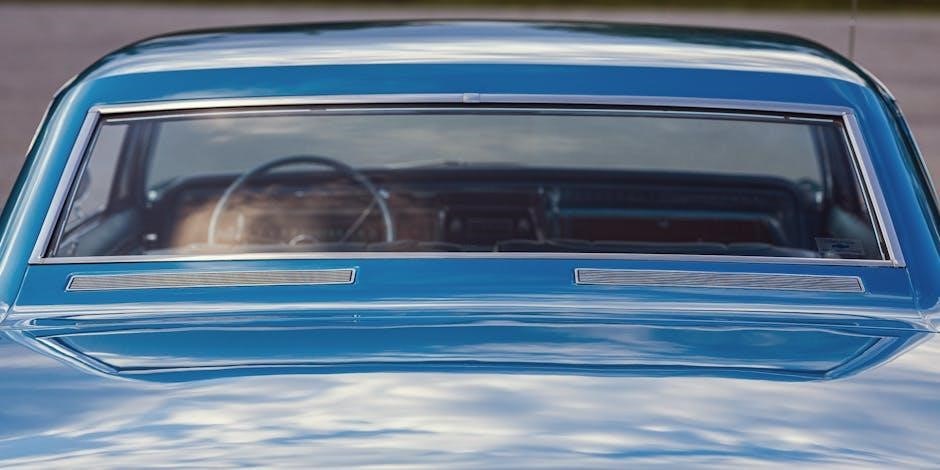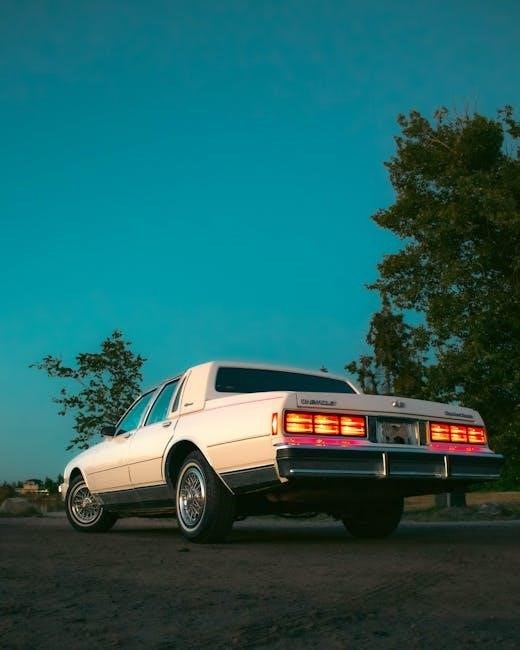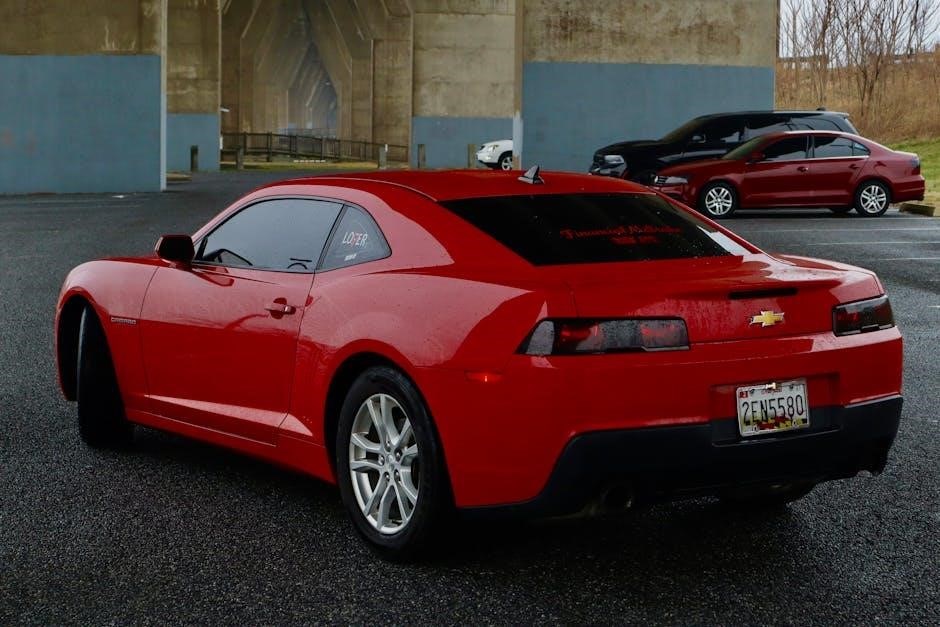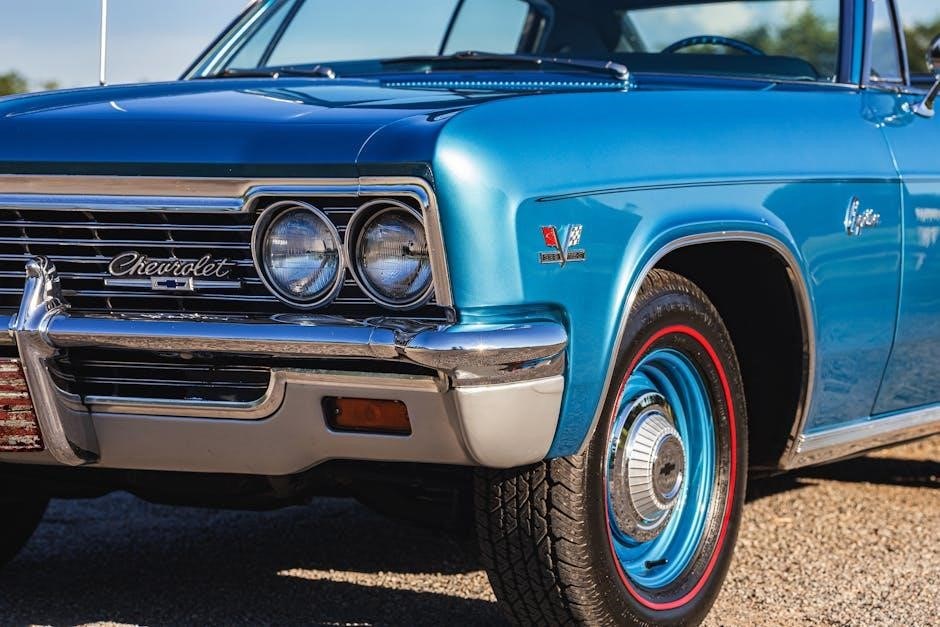The Chevy Silverado’s 4-wheel drive system enhances traction and control, especially in challenging conditions. It features an electronic or manual shift transfer case, enabling seamless mode transitions between 2WD and 4WD. However, manual systems require proper engagement procedures to function effectively.

Overview of the Manual 4-Wheel Drive Engagement Process
Engaging the manual 4-wheel drive on a Chevy Silverado requires a series of steps. First, ensure the vehicle is stationary and shift the transmission into neutral. Next, locate the transfer case shift lever, typically found on the floor. Move the lever to the “4H” or “4L” position, depending on the driving conditions. Some models may require pressing a button or using a switch to activate the system. It’s important to follow the owner’s manual for specific instructions, as improper engagement can lead to system damage or failure. Common issues include faulty actuators or wiring problems, which can prevent engagement.

Common Causes of 4-Wheel Drive Not Engaging
The 4-wheel drive system may fail to engage due to faulty actuators, wiring issues, or problems with the transfer case control module. These components are critical for proper system operation.
Faulty Actuator or Motor
A common issue is a faulty actuator or motor, which controls the transfer case engagement. Symptoms include strange noises, failure to engage, or dash warnings. If the actuator is damaged, it may not respond to electronic signals, preventing 4WD activation. Replacing the actuator or motor often resolves the problem. Some owners have reported success by testing the actuator and transfer case motor separately. Unplugging the actuator and checking for fuse issues can help diagnose the problem. If the actuator is faulty, it may need to be replaced to restore proper 4WD functionality.
Wiring or Electrical Issues
Wiring or electrical problems can prevent the 4WD system from engaging. Damaged or corroded connections, faulty switches, or blown fuses may disrupt the system’s operation. Symptoms include the 4WD light remaining on, inconsistent engagement, or complete failure to activate. Checking the wiring harness and connectors for damage or corrosion is essential. Additionally, ensuring all electrical components, such as the 4WD switch and control modules, are functioning properly can resolve the issue. If the wiring is damaged, repairing or replacing it may be necessary to restore proper system functionality and ensure safe operation.
Transfer Case Control Module (TCCM) Problems
Issues with the Transfer Case Control Module (TCCM) can disrupt 4WD engagement. The TCCM manages electronic signals for mode shifts, and internal faults can prevent proper operation. Symptoms include the 4WD system not responding to switch inputs or displaying error lights. Diagnosing the TCCM requires advanced tools to check for software glitches or hardware failures. In some cases, reprogramming or replacing the module may be necessary. Ensuring the TCCM functions correctly is crucial for maintaining reliable 4WD performance and avoiding further system complications.
Fuse or Circuit Breaker Failure
A blown fuse or circuit breaker in the 4WD system can prevent engagement. The 4WD fuse, typically located in the driver’s side panel, protects the system from electrical overloads. If the fuse fails, the system loses power, and the 4WD cannot activate. Drivers may notice warning lights or complete system unresponsiveness. To diagnose, inspect the fuse and replace it if necessary. Ensure the new fuse matches the amperage rating (usually 15-20 amps). If the issue persists after replacement, further electrical system inspection is required to identify underlying faults, such as short circuits or wiring damage.
Shift Linkage or Encoder Motor Malfunction
A faulty shift linkage or encoder motor can disrupt the 4WD engagement process. The encoder motor is responsible for signaling the transfer case to shift modes, while the shift linkage physically engages the system. If either component fails, the 4WD system may not respond to driver inputs. Symptoms include difficulty switching modes or the system staying in a single mode. Inspecting the encoder motor for wear or damage and ensuring the shift linkage is properly aligned can help diagnose the issue. Replacing these components may be necessary to restore functionality, ensuring smooth transitions between 2WD and 4WD modes.

Diagnostic Steps for 4-Wheel Drive Issues
Start by checking the 4WD fuse and circuit for damage or blown fuses. Test the actuator and transfer case motor for proper function. Use a bidirectional scanner to diagnose PCM/TCM issues. Inspect the shift linkage and neutral safety switch for alignment and connectivity. These steps help identify system malfunctions and guide repairs effectively.
Checking the 4WD Fuse and Circuit
Begin by locating the 4WD fuse, typically found in the driver-side dash panel or under-hood fuse box. Check for a blown fuse or corrosion. If the fuse is blown, replace it with the correct amp rating (usually 15-20 amps). Verify the circuit’s wiring and connectors for damage or wear. Use a multimeter to test for power and ground at the fuse and related components. Ensure all connections are secure and free from corrosion. If issues persist, inspect the circuit for short circuits or open wires. Addressing electrical faults early prevents further system damage and ensures proper 4WD functionality.
Testing the Actuator and Transfer Case Motor
To test the actuator, disconnect it and apply power directly. Listen for engagement sounds. If it fails, replace it. For the transfer case motor, ensure it receives power when activated. Check for obstructions or worn gears. Use a multimeter to verify electrical signals. If the motor doesn’t respond, inspect wiring and connectors for damage. A faulty motor may require replacement. Proper testing ensures accurate diagnosis, preventing unnecessary repairs and restoring 4WD functionality effectively, based on common issues reported by Chevy Silverado owners and experts.
Using a Bidirectional Scanner for PCM/TCM Diagnostics
A bidirectional scanner is essential for diagnosing PCM and TCM issues in the Chevy Silverado’s 4WD system. Connect the scanner to the OBD-II port to read trouble codes, which can indicate problems like faulty actuators or wiring issues. Perform active tests by commanding the 4WD system to engage and monitor the modules’ responses. If the modules send correct signals but the system doesn’t engage, check the actuators or wiring. Incompatible scanners or outdated software may hinder accurate diagnosis. Consider professional help if unsure, but this tool can effectively pinpoint issues, guiding repairs and restoring functionality.
Inspecting the Shift Linkage and Neutral Safety Switch
Inspecting the shift linkage and neutral safety switch is crucial for diagnosing manual 4WD engagement issues. Ensure the shift linkage is properly aligned and free of damage or wear. The neutral safety switch, often located on the transmission, prevents shifting into gear without the clutch pressed. Check its electrical connections and functionality. If the switch or linkage malfunctions, the system may fail to engage 4WD. Clean or replace faulty components as needed. Proper alignment and operation are essential for manual 4WD systems to function correctly, ensuring safe and reliable performance in challenging driving conditions.

Troubleshooting the 4-Wheel Drive System
Troubleshooting involves checking the actuator, wiring, and engagement procedures. Ensure proper neutral detection for low range and verify system overload conditions. Address any electrical or mechanical faults promptly.
Engaging 4-Wheel Drive in Different Modes (4HI, 4LO)

Engaging 4-wheel drive in a Chevy Silverado requires understanding its modes. For 4HI, ideal for higher speeds and light off-road conditions, press the 4HI button while moving at 10-15 mph. Ensure proper traction before accelerating. For 4LO, used for low-speed, heavy-duty tasks, shift to neutral and press the 4LO button. Neutral detection is critical for low range engagement. Avoid sudden acceleration and ensure the vehicle is on level ground. If issues arise, check for system overload or faulty components. Proper mode engagement ensures optimal performance and prevents damage to the 4WD system.
Verifying Neutral Detection for Low Range Engagement
Neutral detection is crucial for engaging 4LO in a Chevy Silverado. The system relies on the transmission being in neutral to activate low range. If neutral isn’t detected, the 4WD system won’t engage. To verify, shift into neutral and ensure the vehicle is stationary. Check the neutral safety switch and wiring for any faults. If issues persist, a faulty encoder motor or TCCM may prevent proper detection. Always refer to the owner’s manual or diagnostic tools for accurate troubleshooting. Proper neutral detection ensures smooth low-range engagement and prevents system damage.
Checking for Overheating or System Overload
Overheating or system overload can prevent the 4-wheel drive from engaging. Prolonged use in high-stress conditions may cause components like the transfer case or axles to overheat, triggering a system shutdown. To check for overheating, inspect the transfer case, axles, and related components for excessive heat. Allow the system to cool down before attempting to re-engage 4WD. If the system overheats frequently, it may indicate improper use or mechanical issues. Always monitor the temperature of critical components and avoid overloading the vehicle in extreme conditions to ensure proper 4WD functionality.
Reprogramming the PCM or TCM

Reprogramming the Powertrain Control Module (PCM) or Transfer Case Control Module (TCM) is a critical step when addressing 4-wheel drive engagement issues. Software updates or corrupted firmware can cause system malfunctions. Using a bidirectional scanner, technicians can reflash the PCM/TCM with the latest manufacturer software, ensuring proper communication between components. This process often resolves issues related to faulty actuator signals, incorrect gear detection, or erroneous error codes. After reprogramming, it’s essential to test the 4WD system in both 4HI and 4LO modes to confirm functionality.

Repair and Replacement Solutions
Addressing 4WD issues may require replacing faulty components like the front axle actuator or encoder motor. Rebuilding or replacing the transfer case can also resolve engagement problems.
Replacing the Front Axle Actuator
A faulty front axle actuator is a common cause of 4WD engagement issues. Replacing it involves disconnecting the electrical connector and removing the mounting bolts. Ensure the new actuator is properly aligned and secured. After installation, test the system by engaging 4WD to confirm functionality. If the actuator was malfunctioning, this should resolve the problem. Always refer to a repair manual for specific instructions tailored to your Silverado’s model year and drivetrain configuration. Proper installation ensures reliable performance and prevents further system damage.
Rebuilding or Replacing the Transfer Case
Rebuilding or replacing the transfer case is a complex process that may be necessary if internal components fail. This involves disassembling the unit to inspect and replace worn parts like bearings, seals, or gears. Specialized tools and mechanical expertise are often required. If rebuilding is not feasible, installing a remanufactured or new transfer case is a viable option. Ensure proper alignment and connection to avoid further system damage. Consulting a repair manual or a professional is recommended, especially for inexperienced owners, to ensure correct installation and prevent future issues.
Fixing or Replacing the Encoder Motor
The encoder motor is a critical component of the transfer case, responsible for detecting gear positions. If it fails, the 4-wheel drive system cannot engage properly. Diagnosis involves checking for electrical connectivity and motor function. If faulty, the encoder motor must be replaced with a genuine OEM or aftermarket part. Proper alignment during installation is essential to ensure accurate gear detection. After replacement, the system should be tested to confirm functionality. Regular maintenance can help prevent premature wear, ensuring reliable performance in all driving conditions.
Addressing Wiring or Connector Issues
Wiring or connector problems are common causes of 4WD engagement failures. Start by inspecting the wiring harness for signs of damage, corrosion, or wear. Check all connectors, especially those near the transfer case and actuator, for loose or corroded connections. Use a multimeter to test for electrical continuity and identify any short circuits or open connections. If damage is found, repair or replace the affected components. Ensure the transfer case control module (TCCM) is receiving proper signals. Refer to a wiring diagram for accurate troubleshooting. Correcting these issues can restore proper 4WD functionality and prevent future malfunctions.

Maintenance Tips to Prevent 4-Wheel Drive Issues
Regularly inspect and maintain components like actuators, wiring, and fuses. Lubricate axles and transfer cases annually. Avoid using 4WD unnecessarily to reduce wear and tear.
Regular Inspection of the 4WD System Components
Regular inspection of the 4WD system components is crucial for maintaining functionality; Check the wiring and connectors for damage or corrosion, and ensure all fuses are intact. Inspect the actuator, transfer case, and shift linkage for wear or misalignment. Verify the encoder motor and neutral safety switch operation. Lubricate axles and transfer case components as recommended. Monitor fluid levels and condition in the transfer case and differentials. Address any leaks promptly. Inspect the 4WD engagement switch and related sensors for proper function. Regular maintenance helps prevent unexpected failures and ensures reliable 4WD performance in challenging conditions.
Lubricating the Transfer Case and Axles
Lubricating the transfer case and axles is essential for smooth 4WD operation. Use high-quality gear oil to maintain optimal viscosity and protect against wear. Inspect and clean the drain and fill plugs before refilling. Ensure the transfer case is properly sealed to prevent leaks. Regular lubrication reduces friction, prevents overheating, and extends component lifespan. Refer to the owner’s manual for the recommended type and capacity of lubricant. Neglecting this step can lead to premature wear, increased noise, and potential system failure during engagement. Consistent maintenance ensures reliable performance in demanding conditions.
Avoiding Overuse of 4-Wheel Drive in Unnecessary Conditions
Avoiding unnecessary use of 4-wheel drive prevents excessive wear on components like the transfer case, axles, and actuators. Engaging 4WD on dry pavement can overheat the system and strain the actuator, leading to potential failure. Overuse increases the risk of premature wear on gears and bearings, which can cause engagement issues. Use 4WD only in low-traction conditions, such as snow, mud, or steep inclines. Always switch back to 2WD on dry roads to minimize strain and extend the system’s lifespan. Proper usage habits help maintain reliable 4-wheel drive performance and reduce the likelihood of costly repairs.

When to Seek Professional Assistance
Consult a professional if 4WD issues persist despite basic troubleshooting. Experts handle complex electrical faults, mechanical overhauls, and system recalibrations requiring specialized tools and expertise.
Complex Electrical or Software-Related Problems
When dealing with intricate electrical or software issues in the Silverado’s 4WD system, professional intervention is crucial. Faulty actuators, wiring problems, or corrupted TCCM software can prevent engagement. Technicians use advanced diagnostic tools like bidirectional scanners to identify and resolve these issues. Reprogramming the PCM or TCM may be necessary to restore system functionality. Without proper expertise, attempting repairs can lead to further damage or safety risks. Always consult a certified mechanic for such complex problems to ensure accurate and reliable solutions.
Major Mechanical Failures Requiring Specialized Tools
Certain mechanical failures in the Silverado’s 4WD system demand specialized tools and expertise. For instance, a damaged transfer case or encoder motor may require disassembly and rebuilding, which is beyond basic DIY capabilities. Replacing components like the front axle actuator or rebuilding the transfer case necessitates precise tools and technical knowledge. Without the right equipment, such repairs can lead to further damage. In these cases, it’s essential to seek assistance from a professional mechanic equipped with the necessary tools and experience to ensure the system is correctly repaired and functions optimally.
Post-Repair System Calibration and Testing
After repairs, proper calibration and testing are crucial to ensure the Silverado’s 4WD system functions correctly. This involves resetting the transfer case control module and verifying all electrical connections. A technician may use specialized diagnostic tools to recalibrate the system and confirm that all components, such as the actuator and encoder motor, are synchronized. Testing should include engaging and disengaging 4WD in both high and low ranges to ensure smooth operation. Failure to calibrate post-repair can result in erratic system behavior, emphasizing the need for thorough testing to restore full functionality and reliability.
